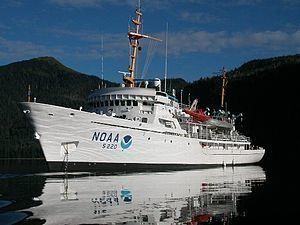Laid down 12 August 1963 Commissioned 2 October 1968 Tonnage 1.443 million kg Displacement 1.633 million kg Builder Jacksonville | Acquired January 1968 Launched 15 March 1967 Weight 1,829 tons Endurance 22 days 0 hours | |
 | ||
Name USC&GS Fairweather (MSS 20) Namesake Mount Fairweather in Alaska Fate Transferred to National Oceanic and Atmospheric Administration 3 October 1970 | ||
NOAA Ship Fairweather (S 220), originally operated by the United States Coast and Geodetic Survey as USC&GS Fairweather (MSS 20), is an oceanographic research ship operated by the National Oceanic and Atmospheric Administration (NOAA). Fairweather primarily conducts hydrographic surveys in Alaskan waters, but is considered a multi-mission-capable vessel and has conducted fisheries research cruises. She is the sister ship of the NOAAS Rainier (S 221) and of the retired NOAAS Mount Mitchell (S 222).
Contents
Overview
Fairweather is named for Mount Fairweather in Alaska. She was constructed for the U.S. Coast and Geodetic Survey as a "medium survey ship" (MSS) by Aerojet-General Shipyards at Jacksonville, Florida. She was laid down on 12 August 1963 and launched on 15 March 1967. The Coast and Geodetic Survey commissioned her as USC&GS Fairweather (MSS 20) in a joint ceremony with her sister ship USC&GS Rainier (MSS 21) at the Pacific Marine Center in Seattle, Washington, on 2 October 1968. When NOAA was established on 3 October 1970 and took over the Coast and Geodetic Survey's assets, she became part of the NOAA fleet as NOAAS Fairweather (S 220). Deactivated in 1989, the ship remained inactive at NOAA's Pacific Marine Center in Seattle for thirteen years. In 2002, she began a refit at the Cascade General Shipyard in Portland, Oregon, and she was recommissioned in 2004 to aid with the backlog of critical surveys in Alaskan waters. Her home port is Ketchikan, Alaska.
Crew
Fairweather, like all NOAA ships, is operated by commissioned officers of the NOAA Corps and civilian wage mariners. Fairweather has a complement of 51 people, with additional berthing capability for visitors and scientists. The ship generally spends over 150 days per year at sea.
Equipment and Mission
Fairweather has two RESON multibeam echosounders, models 7111ER and 8160. Her four survey launches have with RESON 7125sv multibeam echosounders. In addition, Fairweather can tow an L3/Klein System 5000 sidescan sonar, and her launches can be equipped with additional hull-mounted L3/Klein System 5000 sidescan sonars. These sidescan sonars are used for near-shore Arctic survey operations. Additionally, Fairweather's personnel routinely establish horizontal and vertical control instruments, such as Global Positioning System (GPS) base stations and tide-level measuring devices, in the remote areas in which the ship works. Using this technology, the crew of Fairweather can map the ocean floor fully. These data are primarily used to update NOAA's nautical charts, but are increasingly used in other areas such as tsunami displacement modeling, flood mapping, and the mapping of fish habitats.
